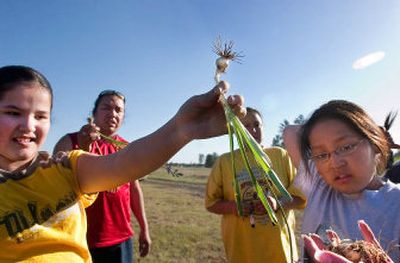Ancestral meal joins generations

PLUMMER, Idaho – He savored the foods of his childhood: fresh camas, strips of pungent bitterroot, a thick, black pudding made from moss on trees.
“A long time ago, my ancestors ate the same thing,” said Merle SiJohn, biting into the soft, white flesh of an uncooked camas bulb. “Our people survived because of these foods.”
An elder from the Coeur d’Alene Tribe, SiJohn can’t remember the last time he and others on the reservation gathered for a meal such as the one they relished Saturday afternoon.
While some families have continued the tradition of gathering roots, it’s been more than a generation, perhaps, since the Coeur d’Alenes as a group hosted a “root feast” – a communal meal featuring bitterroot and camas.
Saturday’s celebration was especially significant to SiJohn and other elders because the roots were gathered by the tribe’s youngest generation – children and teens seeking to learn more about their people’s ancient ways.
Earlier in the week, about a dozen youths from the reservation towns of Plummer and Worley drove all the way to the Cheney area, the ancestral lands of the Coeur d’Alenes, to dig up fresh roots for the elders and others to eat.
Accompanied by members of the tribe’s natural resources department, the students piled into four vehicles after school, arriving at Turnbull National Wildlife Refuge a few hours before sunset.
“Creator, thank you for letting us all be together to dig roots today,” said 13-year-old Joseph Hall when the youths had gathered in a circle to pray. “Thank you for bringing us here safely and for giving us a chance to learn the traditional ways.”
His words were followed by the steady beat of a drum and an honor song cried out by Mark Stanger, who paid homage not only to the Creator and the roots in the ground, but also to the young people who came to dig that day.
Stanger, the tribe’s outreach and education coordinator for natural resources, reminded the students that it was up to them to learn their ancestors’ customs and way of life and to pass them down to future generations.
After the brief ceremony, they wandered throughout the meadow in search of the small, purple flowers that sprouted from the bulbous camas roots.
With shovels, picks and often their bare hands, the young people then dug into the sun-dried earth. In their search for bitterroot amid the gravelly soil where the plants often thrive, the blades of their tools inevitably struck rocks.
“Is this camas?” one girl asked, pulling out a long green stalk attached to a white bulb the size of a nickel.
“No,” replied another girl. “That’s an onion.”
While a few of the kids had experience digging for roots and were able to discern the camas’ tiny blossoms from the other plants in the field, the rest had never been involved in such an expedition.
Unless they grew up with their “yaya,” or grandmother, and other tribal elders, young people are rarely exposed to the traditional ways, said Lovina Louie-Garvais, the tribe’s youth coordinator.
Camas and bitterroot have been eaten by the Coeur d’Alenes and other tribes for thousands of years, she said. While the men hunted for deer and elk or fished for salmon, it was up to the women to gather the roots. “It was a sacred thing for women to do,” she explained.
The camas and bitterroot not only nourished their families, she said; they also were used for trade with other tribes.
Because root gathering and other customs have been lost over the decades as a result of modernization and assimilation into the mainstream culture, Louie-Garvais, Stanger and others want to revive these traditions so that their children and grandchildren can pass them along to future generations.
“When you dig roots, it’s important that you have a good heart and a good mind,” Louie-Garvais reminded the youngsters.
She advised them to be careful as they unearth the camas – dig too closely and you can break the bulb, she warned. After pulling the roots from the ground, she told them to remove the peel and sprinkle it back into the dirt. Take only what you need, she said, and be grateful for the Creator’s gifts.
“It’s cool to do something that our people have been doing for centuries,” said Vanessa SiJohn, 11. “It’s part of our culture.”
The 30 handfuls of camas and bitterroot that the young people collected earlier in the week were served in paper bowls Saturday afternoon along with other traditional foods such as smoked salmon, dried buffalo meat, huckleberries and fry bread.
About 100 people flocked to the Coeur d’Alene Tribal Wellness Center for the root feast, which was prepared by Jeanette Timentwa and other members of her family.
“Our Indian traditions are going down the drain,” lamented Timentwa, an elder from the Arrow Lakes band of the Colville Confederated Tribes. “We have to teach our kids to respect Indian foods and teach them how to dig.”
Horace Axtell, a Nez Perce elder, reminded the people gathered for the meal that the food they were about to eat was sacred, along with the water that helped the plants grow.
Merle SiJohn, who sat at the head table with Timentwa and Axtell, recalled how his grandmother regularly cooked the roots for him and his family. Because he never learned how to prepare camas and bitterroot, he enjoys these delicacies only once or twice a year at special celebrations. Each time he eats them with his bare hands, SiJohn said, he can’t help but think of the people who came before him.
“It’s important that we bring back tradition,” said Stanger. “Many of the people who knew how to make these foods are no longer with us. So those who are still alive must teach and pass it along.”